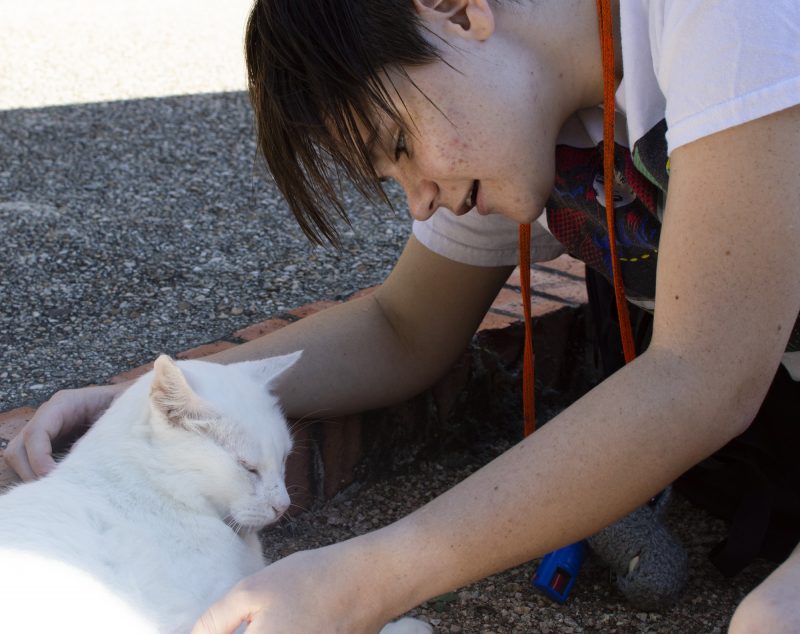When junior Abbi Bowen posted a photo of a mauled bird carcass on the Overheard at Trinity Facebook page, she was hoping to spark a debate about the role of cats on campus.
“We just need to rile people up or something. I never post on Overheard at Trinity, but I just did it because I knew people would freak out about it. When we came across that bird that was obviously torn apart by a cat, we were just fed up with the fact that no one is really talking about it,” Bowen said.
Cats have lived among Trinity students for about 14 years. The Cat Alliance, an independent nonprofit directed by Trinity staff, has supervised the feral cat population through feeding them, as well as spaying, neutering and medicating sick cats. Students often join the organization to help feed and monitor the cats.
“When we started this program 14 years ago, there were 60+ cats on campus. Through our system of management, we are down to just over 20,” said Vee DuBose, a co-founder of the Cat Alliance and the publications designer in the Office of Strategic Marketing and Communication.
According to DuBose and Mindy Morales, another founding member of the Cat Alliance, Trinity students have a warm perception of cats living on campus and regard them as pets. Students frequently approach members of the Cat Alliance to tell them the cats were part of the reason why they chose to attend Trinity.
However, Bowen is a part of the growing population that worries the cats are harming Trinity’s ecosystem.
“Because outdoor cats are seen as invasive species, it’s important for the local ecology that you don’t just have this other species messing with it,” Bowen said.
Bowen’s opinion is shared with several biology professors, such as Kelly Lyons. To raise awareness of the potential harm cats bring to Trinity’s natural environment, Lyons co-wrote a column with professors Michele Johnson, Troy Murphy and David Ribble for the Trinitonian in 2016. Comments on the Overheard at Trinity post by Bowen on Oct. 5 referenced the column, which was also published in the Rivard Report. Lyons still believes that the cat situation warrants a more serious discussion.
“We need to have a better policy on campus. It’s only fair to the wildlife on campus and other animals that people may like to look at and enjoy that we do something about the cats. They have significant effects on wildlife. If you care at all about urban biodiversity, you really need to be involved in the cat management part of it,” Lyons said.
Steffanie Mortis, a director for the Cat Alliance and assistant editor and education and programming coordinator for TU Press, doesn’t see the cats as a large threat to wildlife on campus.
“The Trinity cats are very well fed. For the most part, they are elderly, senior cats. Many of them are not in good shape to go out hunting. As far as we know, there haven’t been a lot of reports of signs that the cats have been hunting, like bird carcasses or feathers. That said, we can’t stop cats from being cats, even though they’re fed regularly,” Mortis said.
The directors said the criticisms of the cats’ effect on Trinity’s ecosystem have not been sent to them directly. They also feel that the cats do not pose as much a threat to birds as flying into glass windows does, as they’ve frequently spotted dead birds outside of windows around campus.
“The people who are concerned about the bird population should lobby the university to pay for the special glass to keep birds from smashing into it,” Morales said.
Junior Emma Frieze witnessed the dead bird that Bowen posted a photo of, saying it had collided with a window.
“I saw the bird on the ground, dead. It looked like it had run into the window, because it’s neck was snapped and there was nothing gross around it. I saw the Facebook post and thought, ‘I don’t really care what the point of this is.’ The bird was already dead, please let the cat eat it,” Frieze said.
Lyons feels that if the school were to keep the cats indoors, the risk for harming biodiversity would be mitigated.
“One of the things that I probably didn’t mention enough in the [2016] Trinitonian article is that we need a ‘cat-atorium’ — a cat porch that can be attached to a building. Students can go in and see the cats, but they stay indoors. If we have a cat-atorium, students can come and walk them. That would solve a lot of the problem. Having cats roaming around is bad for the cats, it’s not great for the students and they really shouldn’t be in students’ dorm rooms,” Lyons said.
The Cat Alliance emphasized that their care-taking methods were modeled after larger universities and are becoming popular at colleges across the state and country.
“There might be a misperception that we’re crazy cat people who just feed cats, but what we do is carefully thought out. Not just by us, but by many respected universities with a scientific approach and we carry it out that way as well. We’re careful — we’re not just out there feeding cats and throwing out kibble and ignoring everything else,” Morales said.
Lyons and Morales do agree on one issue: the cat overpopulation problem is man-made.
“TNR [Trap-Neuter-Return] as a program is not Plan A for any cat. But because of the world, and especially because of the pet ownership culture in San Antonio, man has indeed created this problem. It’s going to take years to resolve the problem of overpopulation of pets. We’re with plan B, and that is to do something as humanely as we can in a way that benefits as many as possible. It’s not perfect, we know that,” Morales said.
Lyons feels that a viable option to regulate the cat population would be to enforce the use of leashes. She wants students to continue the discussion, but only if it’s from a logical perspective.
“We would love to do a panel discussion and really blow the top off of this. The problem is that, we find over and over again, the discussion becomes very quickly about the love of the cats. That’s not a rational discussion,” Lyons said. “We feel that we can come to the table as scientists with evidence, with solutions and suggestions, but we’re not really open to being skewered by a very emotional perspective on this.”
with additional reporting by Kaylie King







